Motions Of The Earth Exercises
Question 1. Answer the following questions briefly.
- What is the angle of inclination of the earth’s axis with its orbital plane?
- Define rotation and revolution.
- What is a leap year?
- Differentiate between the Summer and Winter Solstice.
- What is an equinox?
- Why does the Southern Hemisphere experience Winter and Summer Solstice at different times than that of the Northern Hemisphere?
- Why do the poles experience about six months of day and six months of night?
Answer:
(1). The angle of inclination of the earth’s axis is 23 1/2°. The axis forms an angle of 66 1/2° with its orbital plane.
(2). (1) Rotation. The movement/motion of the earth on its axis in 24 hours is defined as rotation.
(2) Revolution. The movement/motion of the earth around the sun in its orbit in 365(4 days is called a revolution.
(3). Leap Year. The year (every fourth year) with 366 days instead of 365 days is known as a leap year. February, in this year, has 29 days.
Read and Learn More CBSE Solutions For Class 6 Social Science
(4). Difference between Summer and Winter Solstice
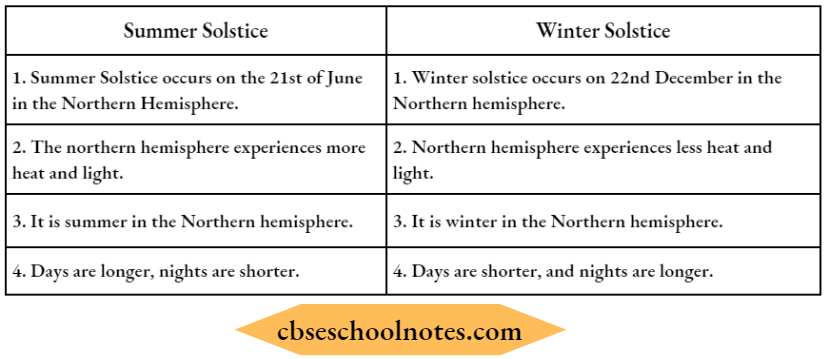
(5). Equinox is the position of the Earth on 21st March and 23rd September. On these days both the hemispheres experience equal days and nights.
- On 21st March, it is spring equinox in the Northern Hemisphere. Autumn equinox is in the Southern hemisphere.
- In the Northern hemisphere on 23rd September, the position of the earth is Autumn equinox. On the same day in the Southern Hemisphere, it is spring equinox.
(6). The Southern Hemisphere experiences winter and summer solstice at different times than, that ofthe Northern Hemisphere because of the following reasons:
- The southern hemisphere is tilted towards the sun on 22nd December, hence summer solstice is there in the Southern hemisphere.
- At that time winter solstice is in the Northern hemisphere when it is away from the sun.
- On the contrary on 21 June, the Northern hemisphere is tilted towards the sun. Hence summer solstice is in the Northern hemisphere and winter solstice is in the Southern hemisphere.
(7). The poles experience six months’ day and six months’ night because of the following reasons:
- When the Northern Hemisphere is tilted towards the sun, the North Pole remains in the light for the whole of the day (24 hours). This position remains for six months (from 21st March to 23rd September).
- On the contrary in the Southern hemisphere, the South Pole does not get light during these six months. Hence it experiences night for six months.
- When the Southern hemisphere is tilted towards the sun, the South Pole remains in light for 24 hours for six months from 23rd September to 21st March. Reverse are the conditions at the North Pole —six months’ night.
Question 2. Match the correct answers.
(1). The movement of the earth around the sun is known as
- Rotation
- Revolution
- Inclination
Answer: 2. Revolution
(2). Direct rays of the sun fall on the equator on
- 21 March
- 21 June
- 22 December
Answer: 1. 21 March
(3). Christmas is celebrated in summer in
- Japan
- India
- Australia
Answer: 3. Australia
(4). Cycle of the seasons is caused due to
- Rotation
- Revolution
- Gravitation
Answer: 2. Revolution
Question 3. Fill in the blanks.
(1). A leap year has ________ number of days.
Answer: 366
(2). The daily motion of the earth is __________.
Answer: Rotation
(3). The earth travels around the sun in _________ orbit.
Answer: Elliptical
(4). The sun’s rays fall vertically on the Tropic of ________ on 21st June.
Answer: Cancer
(5). Days are shorter during ___________ season.
Answer: Winter
Question 4. What would happen if the earth did not rotate?
Answer:
If the earth did not rotate,
- The portion before the sun would have remained the same and continued to experience day regularly. That portion will become too hot.
- On the other hand, the portion of the earth away from the sun would have experienced night continuously. This portion will become too cold.
- Life would not have been possible on Earth in such a situation.
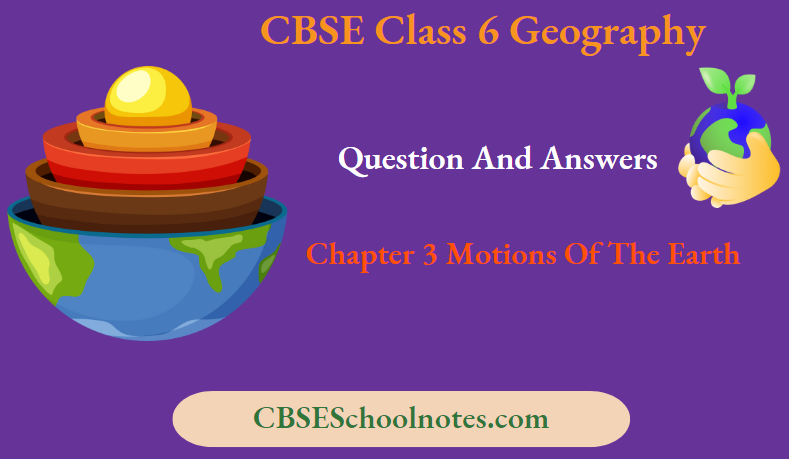
Question 5. Do you know that Christmas is celebrated in Australia in the summer season?
Answer:
Yes, we know that in Australia Christmas is celebrated in the summer season, i.e., 25th December when there is summer in Australia (the Southern Hemisphere).
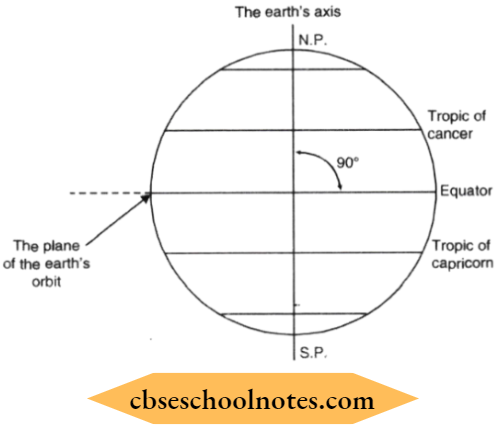
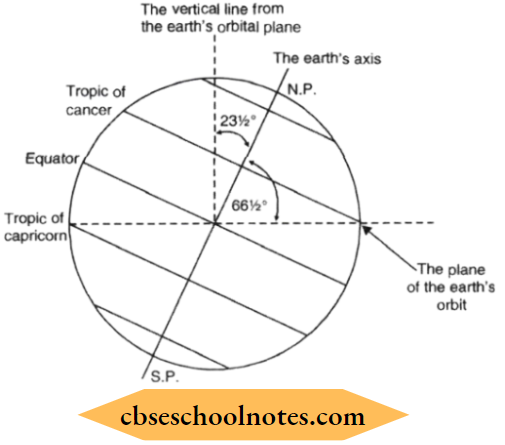
Motions Of The Earth Very Short Type Questions And Answers
Question 1. What do you mean by orbital plane?
Answer:
The plane formed by the earth by revolution around the sun is called the orbital plane.
Question 2. Define an Earth Day.
Answer:
The period of rotation by the earth on its axis is described as an earth day, i.e., 24 hrs.
Question 3. What are the axis and orbit?
Answer:
Axis: The axis of the earth is an imaginary line joining the North Pole with the South Pole. It makes an angle of 66V20 with its orbital plane.
Orbit: Orbit is the elliptical path on which heavenly bodies move around the sun or planet.
Question 4. What is the circle of illumination? Why does it not coincide with the axis of the earth?
Answer:
The circle which separates day from night is called the circle of illumination.
This circle does not coincide with the axis because of the inclination of the axis by 23 1/4° towards the east.
Motions Of The Earth Short Type Questions And Answers
Question 1. Distinguish between rotation and revolution.
Answer:
The distinction between rotation and revolution is as under:
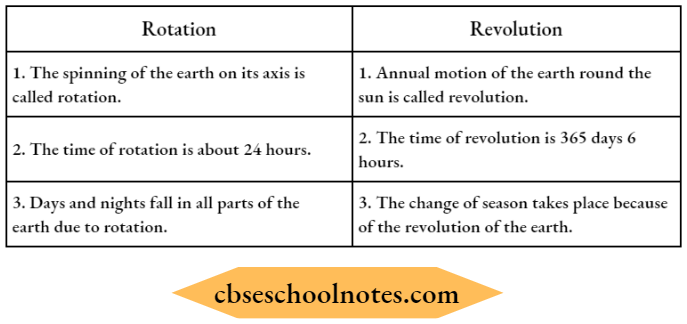
Question 2. How are days and nights formed?
Answer:
- The earth receives light from the Sun.
- Because of its spherical shape; only half of it gets light from the sun at a time.
- The portion facing the sun experiences daytime while the other portion away from the sun experiences night.

Motions Of The Earth Long Type Questions And Answers
Question 1. How is a leap year formed?
Answer:

Question 2. What do you understand by equinox?
Answer:
On 21 March and 23 September, the sun shines vertically on the equator.
- In this position, neither of the Hemispheres are tilted towards the Sun, so the whole of the earth experiences equal days and equal nights.
- Equinox is neither very cold nor very hot all over the world.
- The Northern Hemisphere experiences spring on the 21st of March and autumn on the 23rd of September.
- Precisely the opposite happens in the Southern Hemisphere. Here, it is spring on September 23rd and autumn on March 21st.
- Equinox positions are called Spring and Autumn Equinoxes respectively.
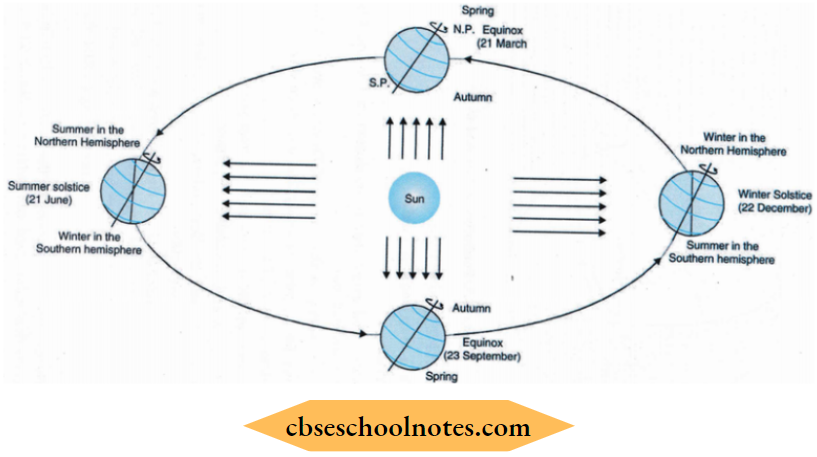
Question 3. How are seasons caused?
Answer:
The Earth revolves around the sun in an elliptical orbit.
- seasons axis is inclined in a fixed direction (east) on its orbit by 23 1/2°.
- The revolution of the earth and the inclination of the earth’s axis in a fixed direction cause seasons.
- A year is divided into four seasons.
- seasons are Spring, Summer, Autumn, and Winter.
- Seasons change with the change in the position of the Earth around the sun.
Question 4. Explain Summer Solstice and Winter Solstice.
Answer:
On 21st June, the Northern Hemisphere is tilted towards the sun.
- On that day the sun shines directly on the Tropic of Cancer (23 1/4° N). Hence, these areas receive more heat.
- The areas near the poles receive less heat because the rays of the sun are slanting there.
- The North Hemisphere is inclined towards the sun and the places beyond the Arctic Circle experience continuous daylight.
- As a large portion of the Northern Hemisphere gets light from the sun, therefore, it is Summer in the Northern Hemisphere.
- The duration of the day is longer and that of the night is short here.
- At this time in the Southern Hemisphere, all these conditions are opposite.
- The southern hemisphere is winter season there.
- Nights are longer than days.
- The southern hemisphere position of the earth is called the Summer Solstice.
- On 22nd December, the Tropic of Capricorn receives the direct rays of the sun, and the Southern Hemisphere tilts towards the sun.
- The places beyond the Antarctic Circle experience continuous daylight.
- On 22nd December this day, the sun shines vertically on the Tropic of Capricorn (23 1/4° S).
- Hence a larger portion of the Southern Hemisphere gets light.
- It is summer in the Southern Hemisphere with longer days and shorter nights.
- The opposite conditions are prevalent in the Northern Hemisphere.
- This position of the earth is called winter solstice.
Motions Of The Earth Multiple Choice Questions And Answers
Question 1. The motion of the earth on its axis in about 24 hours is called:
- Revolution
- Rotation
- Both (1) and (2)
- None of these
Answer: 2. Rotation
Question 2. The motion of the earth around the sun is known as:
- Revolution
- Rotation
- Equinox
- Solstice
Answer: 1. Revolution
Question 3. What is the orbital plane?
- Plane formed by the axis
- Plane made by the earth while revolving around the sun
- Both (1) and (2)
- None of these
Answer: 2. Plane made by the earth while revolving around the sun
Question 4. Which one of the following is the source of light on the earth?
- The Moon
- The sun
- The satellite
- The space
Answer: 2. The sun
Question 5. The circle that divides the globe into day and night is called:
- Circle of Darkness
- Circle of Day and Night
- Circle of illumination
- None of these
Answer: 3. Circle of illumination
Question 6. The period of one rotation of the earth is known as:
- The sun day
- The moon day
- The earth day
- None of these
Answer: 3. The earth day
Question 7. What would have happened if the earth did not rotate?
- Cold conditions on Earth’s half portion
- Warm conditions on earth’s other half portion
- No life is possible in such extreme conditions
- All of these
Answer: 4. All of these
Question 8. Why do seasons change on the earth?
- Due to change in the position of the earth around the sun
- Due to no change in the earth’s position
- Both (1) and (2)
- None of the above
Answer: 1. Due to change in the position of the earth around the sun
Question 9. When do the longest day and the shortest night occur in the northern hemisphere?
- June 21
- September 23
- December 22
- March 21
Answer: 1. June 21
Question 10. In which season Christmas is celebrated in Australia?
- Winter season
- Summer season
- Autumn season
- Spring season
Answer: 2. Summer season
Question 11. Days and nights occur on earth due to:
- Rotation
- Revolution
- Both (1) and (2)
- None of these
Answer: 1. Rotation
